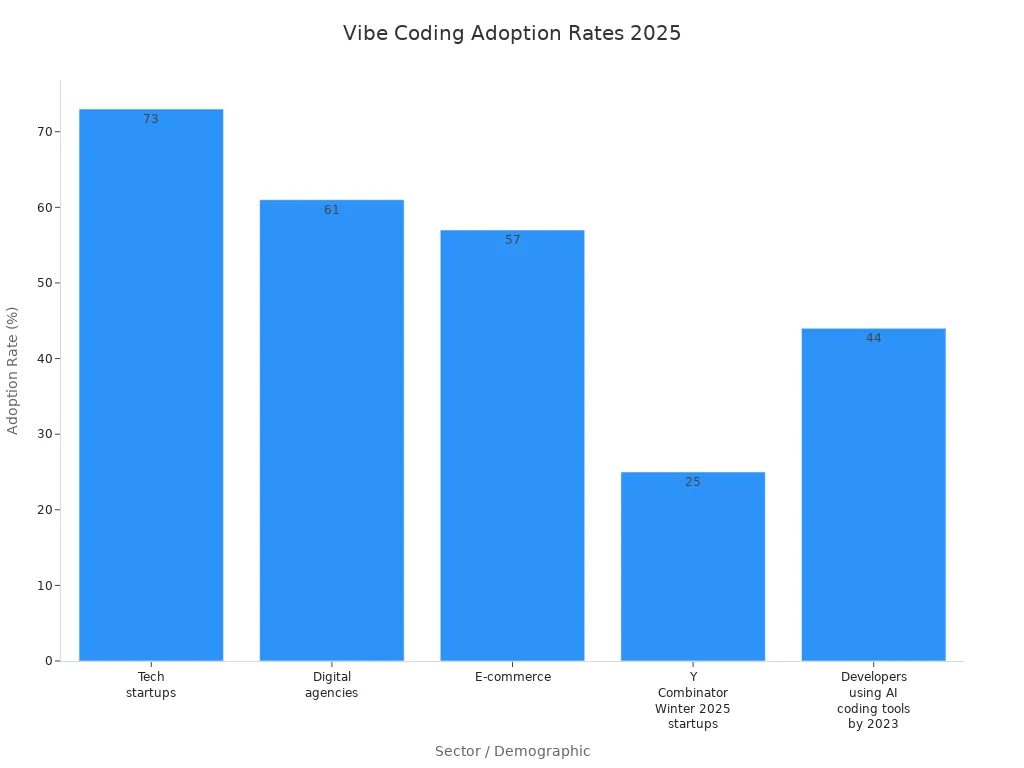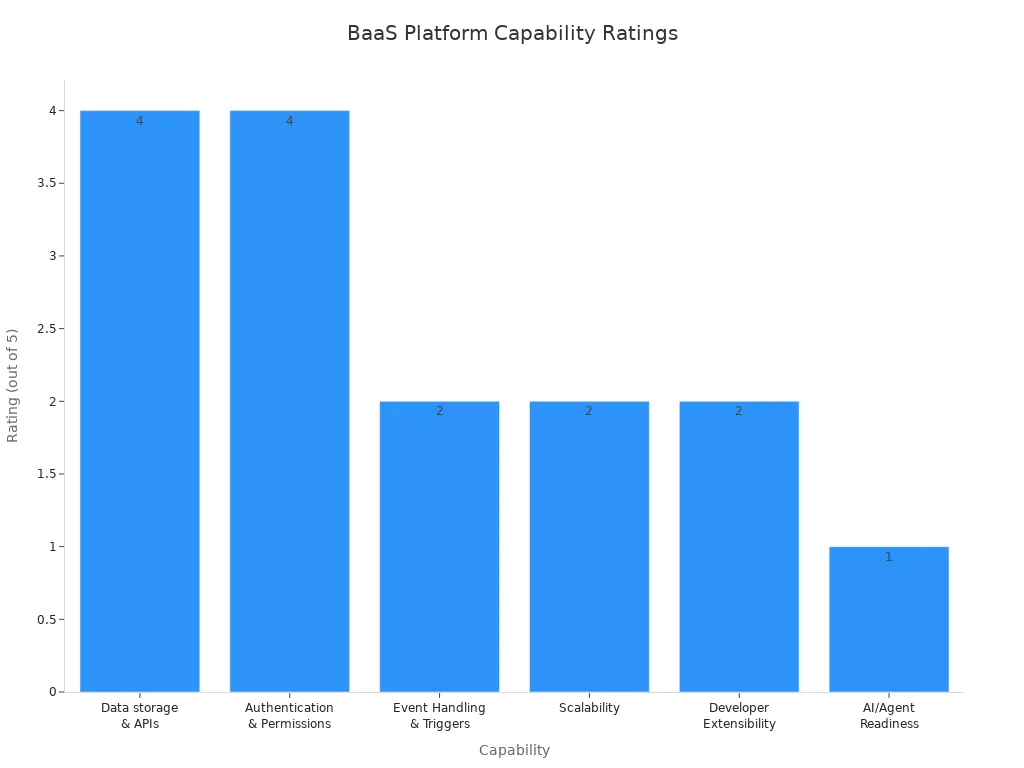Vibe coding best practices and the best BaaS options for 2025

You see vibe coding changing how you make apps in 2025. Tech startups use vibe coding best practices a lot. The adoption rate is 73%. Digital agencies and e-commerce are not far behind.
Sector / Demographic | Adoption Rate / Statistic |
|---|---|
Tech startups | 73% adoption rate of vibe coding practices |
Digital agencies | 61% adoption rate |
E-commerce | 57% adoption rate |
Y Combinator Winter 2025 startups | 25% have codebases ~95% AI-generated (deep vibe coding integration) |
Developers using AI coding tools by 2023 | 44% adoption rate (foundation for 2025 growth) |

Last year, you saw AI-powered tools and BaaS platforms change app development. Banks use AI for automation and security. This cuts data mistakes by 40%. Developers use ai vibe coding tool options for making apps from start to finish. This makes apps safer and faster to build. You see apps with vibe coding best practices work better. Momen helps you make modern apps with advanced AI. This pushes new ideas in development.
Vibe Coding Best Practices

Code Structure
Good code structure helps your app grow and stay easy to fix. Vibe coding best practices start with clear plans and breaking code into parts. When you use AI-generated code, you need to guide it to stop problems later. Bad structure can cause bugs, security issues, and hard-to-fix apps.
Modular architecture lets you add features without breaking things.
Keeping code parts separate makes it easier to test and understand.
Automated tests and CI pipelines find problems early.
Checking code often and using prompt engineering keeps quality high.
Watching and checking AI code helps you stay responsible.
Careful engineering mixes fast vibe coding tools with good habits for long-term wins.
Always check AI-generated code with reasoning models to find hidden mistakes. This step helps keep your code safe and strong.
Naming Conventions
Using the same naming rules makes code easy to read and fix. In 2025, you follow these rules for vibe coding best practices:
Use camelCase for variables and functions (like getUser).
Use PascalCase for types and exported names (like UserService).
Use ALL_CAPS for constants (like MAX_RETRIES).
Pick short, clear names (like userCount).
Clear names help everyone understand how the app works. Using the same names and writing notes helps teams work together. When you write down what your code does, new people learn faster. Code checks and working together help you stay creative but also clear. Good vibe coders use these habits to keep projects moving.
Error Handling
Strong error handling keeps your app from crashing or stopping. You should:
Check all inputs to stop bad data and attacks.
Handle problems with retries, backups, and circuit breakers.
Watch things like speed and success to find problems fast.
Write down errors with details to fix them quickly.
Use health checks to see if the app is working.
You make your app stronger by keeping problems apart and using queues for failed jobs. Tools like Prometheus and Grafana help you find and fix issues fast. These steps keep your app working well for users.
Security and Privacy
Security is very important in vibe coding best practices. You must keep private data safe and protect your app at every step.
Use Git best practices, like .gitignore, to hide secrets from your code.
Keep passwords, API keys, and tokens away from your code.
Stop DDoS attacks with network safety tools.
Check and clean user inputs to stop path problems.
Watch your code’s outside parts for weak spots.
Add security checks with SAST and DAST tools.
Keep records to show what happened for rules and safety.
Never trust only AI for security. People must check for things AI might miss. Easy security tools help you control risks, even for non-coders. Training and clear rules help your team stay ready for new dangers. New laws, like the EU AI Act, mean you must track and check your AI apps. Doing these things keeps your users’ data safe and follows the rules.
Performance Tips
You make your app faster by using smart tools and planning.
Use AI-powered vibe coding tools to do boring tasks and build faster.
Use CI/CD pipelines to launch updates quickly and catch bugs early.
Make images smaller and code shorter to help your app load fast.
Work in quiet places to focus better.
Use short, timed work sessions and plan your time for deep work.
AI coding works best when you know how to ask it the right way and plan before you start. Build your app in small parts and fix things often. This keeps your code clean and easy to grow. You help users by making the app load fast and work smoothly.
Collaboration
Working together helps your team do better work. You set up clear rules for coding so everyone knows what to do.
Check each other’s code often to share ideas and improve.
Use pair programming and AI tools to match team styles.
Make rules for using AI and writing notes for everyone to see.
Mix computer and human code checks for safer, better apps.
Treat AI like a new team member and give it feedback.
People should always check important features and logins.
Teach your team new skills to use vibe coding tools well.
Tools like Git and GitHub help teams work on code together. Using branches and small changes makes code checks easier. Telling AI to write good commit messages and pull requests helps everyone see what changed. These habits help you build apps that are safe, easy to fix, and ready to grow.
Best Vibe Coding Tools
Top Tools 2025
You want to build better apps, so you need the best vibe coding tools. In 2025, you see many options that help you create, test, and launch apps faster. These tools use AI to turn your ideas into working code. You can use natural language prompts to describe what you want. The tool then builds the app for you. This makes it easy for you to focus on your app’s features and user experience.
Here are some of the best vibe coding tools you should know:
Cursor: This AI-native IDE reads your whole codebase. You can use @-mentions to reference files. Cursor helps you make big changes quickly and keeps your app organized.
Vercel v0: You use this tool to deploy and scale your apps. It works well with modern frameworks and supports fast updates.
Bolt: Bolt lets you build full apps from simple prompts. You can create prototypes or launch real apps without much setup.
Windsurf: Windsurf watches your actions and suggests changes. It helps you edit many files at once and keeps your app running smoothly.
Replit: Replit gives you a place to code, test, and share apps online. You can start with a prompt and see your app come to life.
GitHub Copilot: Copilot works inside your IDE. It suggests code, plans tasks, and even writes tests for your app.
These vibe coding tools help you build apps with less effort. You can use them to create apps for web, mobile, or backend systems.
Tool Comparison
You want to pick the best vibe coding tools for your next app. Each tool supports natural language prompts and deep-context agents in different ways. The table below shows how these tools help you build smarter apps:
Tool Name | Natural Language Prompts | Deep-Context Agents | Key Features |
|---|---|---|---|
Cursor | Yes | Yes | Reads entire codebase, @-mentions, multi-line autocomplete, sandboxed agent workspaces |
Windsurf | Yes | Yes | Cascade interface, multi-file editing, proactive suggestions, semantic indexing |
GitHub Copilot | Yes | Yes | IDE integration, agent mode, context-aware suggestions, autonomous coding and testing |
Replit | Yes | Partial | Full app generation from prompts, rapid prototyping, online IDE |
Bolt | Yes | Partial | App generation from prompts, fast prototyping, non-technical user focus |
Vercel v0 | Partial | Partial | Fast deployment, scaling, works with modern frameworks |
Tip: You get the most from these tools when you combine them. For example, you can use Cursor to write code, Copilot to suggest improvements, and Vercel v0 to deploy your app.
You see that the best vibe coding tools let you build apps from a single prompt. They understand your project’s context and help you manage complex tasks. With these tools, you can launch apps faster and keep your codebase clean.
BaaS Options for Vibe Coding

Selection Criteria
Picking the right Backend as a Service platform is important. You want a platform that fits your app and your team. Here are the main things to check:
Make sure the platform matches your app’s needs and can grow.
Pick one that your team knows how to use.
Check if the price and license fit your budget.
See if you can build Android, iOS, and web apps.
Look for easy-to-read guides and simple screens.
Choose a platform that runs fast for users.
Find a strong community for help and tips.
Make sure it works well with other tools.
Tip: Firebase is popular because it is easy to use and helps you build apps quickly.
Top BaaS Platforms
In 2025, some BaaS platforms are very popular for vibe coding. Supabase and Appwrite help you set up databases and user login fast. Supabase uses PostgreSQL, which is strong for web and mobile apps. You get updates right away, flexible hosting, and open-source freedom. Appwrite lets you host it yourself and works with many languages.
Supabase makes backend work easy with a simple dashboard and automatic APIs. You can grow your app from small to big. Supabase also has AI features like vector search and chat AI, so you can make smart apps. Appwrite is good if you want to control your backend and use cloud functions in different languages.
Firebase is another top choice. You get real-time sync, user login, and quick setup. AWS Amplify connects you to many AWS services and has AI/ML features. You can use a visual builder to make apps faster.
Remember, BaaS platforms are best for teams that focus on the frontend and want to build apps quickly. They help you launch MVPs and web apps fast. But you need to set up security carefully to keep your app and users safe.
Momen Overview
Momen is a strong no code tool for building AI-powered apps without code. You can use Momen’s drag-and-drop tools to make apps easily. The platform gives you a GraphQL API, so you get data fast and skip old guides. You get a headless backend, so you can use Momen with any frontend or native app.
You can build smart AI agents and backend flows using Actionflows. Momen lets you add custom JavaScript, so you can do advanced things. You get strong data safety, so your app’s info stays safe. Momen supports custom React parts, so you can make cool web app designs.
You get tools for working together, setting access, and seeing changes right away. Momen’s AI tools and workflow help you build and change apps fast. You can grow your app to millions of users and use simple security controls. The platform shows clear prices, so you know what you pay.
Note: Momen works with Lovable, so you can connect your frontend to smart AI logic and build apps from start to finish easily.
Platform Comparison
You want to see how the top BaaS platforms stack up for vibe coding. The table below shows main features and prices for Momen, Supabase, Firebase, and AWS Amplify.
Platform | Key Features | Pricing Highlights |
|---|---|---|
Momen | No-code app building; AI agent support; GraphQL API; Actionflows; custom React; real-time preview; teamwork tools; easy security; clear prices | Free plan with 100,000 AI Points; clear project pricing; grows to millions of users |
Supabase | Open-source; PostgreSQL backend; real-time updates; flexible hosting; AI support; automatic APIs | Free: 2 projects, 500MB DB, 1GB storage; Paid starts at $25/month; extra features cost more |
Firebase | Real-time sync; user login; quick setup; big community; easy app building | Free plan; pay for extra features |
AWS Amplify | AWS service links; works with many frameworks; AI/ML features; visual builder | Free: 1000 build minutes/month, 5GB storage for 1 year; then pay as you go |

Most BaaS platforms score high for data storage, APIs, and user login. They help you set up your backend fast and keep your app running well. But they are not as flexible for complex events and advanced AI flows. Momen gives you more control, flexibility, and AI support for building apps from start to finish.
Best for: Use BaaS platforms for quick prototypes, web apps, and mobile apps. Pick Momen when you want advanced AI, custom flows, and a smooth user experience.
Integrating Vibe Coding with BaaS
Workflow Examples
You can use vibe coding tools with BaaS to build apps fast. First, you say what your app should do in simple words. Cursor or Copilot X can turn your ideas into code. Momen or Firebase handle the backend, so you focus on features.
A normal workflow goes like this:
Say what your app does using natural language prompts.
Use AI assistants to make or fix your code.
Check your code with AI review tools. They find bugs and security problems before you launch.
Change your code and notes after feedback. This keeps your app neat and your docs current.
Launch your app with the BaaS platform. You get real-time databases, serverless functions, and asset hosting for quick launches.
You can update notes and coding rules as you work. AI tools help you try new things and add features easily. Momen is flexible and simple, so you can build apps that grow and change.
Tip: Use AI code generation with BaaS features like real-time data and serverless logic. This makes your app faster to build and keeps your work easy.
Common Pitfalls
You might have problems when you use vibe coding with BaaS. Watch out for these mistakes:
Leaving database access open can show user data. Always turn on row-level security and set strong access rules.
Only checking permissions on the client side can cause security holes. Move important checks to the backend or serverless functions.
Hardcoding secrets like API keys in your code can be risky. Store secrets in safe environment variables or use a secrets manager.
Not checking user input can let bad data in. Always check and clean user input.
Using old or unsafe dependencies can make your app weak. Check your dependencies and use static analysis tools.
You can skip these problems by following good security steps and using tools that check your app. This keeps your integration safe and your apps strong.
You boost your app’s quality by following vibe coding best practices and using top tools like Cursor and Copilot. Choosing a BaaS such as Momen gives you strong AI features and easy workflows. To stay ahead in 2025, try these steps:
Use specific prompts with AI to shape your app’s framework and UI.
Refine your code by chatting with AI and testing changes.
Run your app on real devices for quick feedback.
Describe bugs in plain language so AI can help you fix them.
Stay curious and keep learning as vibe coding and BaaS platforms evolve.
FAQ
What is vibe coding?
Vibe coding means using AI tools and natural language prompts to build apps faster. You describe what you want, and the tool creates code for you. This method helps you focus on features and user experience.
How does Momen help with AI-powered app development?
Momen lets you build, test, and deploy AI agents and backend workflows without code. You use visual tools to connect data, set up logic, and integrate advanced AI models. This makes app development faster and more flexible.
Can I use Momen with other frontend platforms?
Yes, you can connect Momen to any frontend, including Lovable. Momen provides a prompt generator and GraphQL API. This setup lets you link your UI to powerful AI logic and backend workflows easily.
What are the main security tips for vibe coding with BaaS?
You should always secure your secrets, use strong access rules, and check user input. Store API keys safely. Set up backend checks for permissions. Use tools that scan for security risks.
How do I choose the best BaaS for my project?
Check your app’s needs, team skills, and budget. Look for easy integration, strong documentation, and good support. Compare features like real-time data, AI support, and scalability. Try free plans to see what fits best.
See Also
Top No-Code Solutions For Freelancers To Use In 2025
Complete 2025 Handbook For Building Your MVP Successfully
Seven Best No-Code Platforms For Non-Technical Founders 2025
